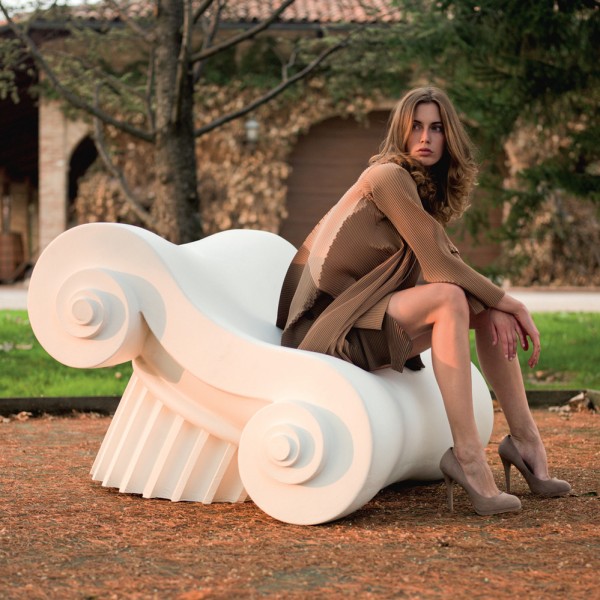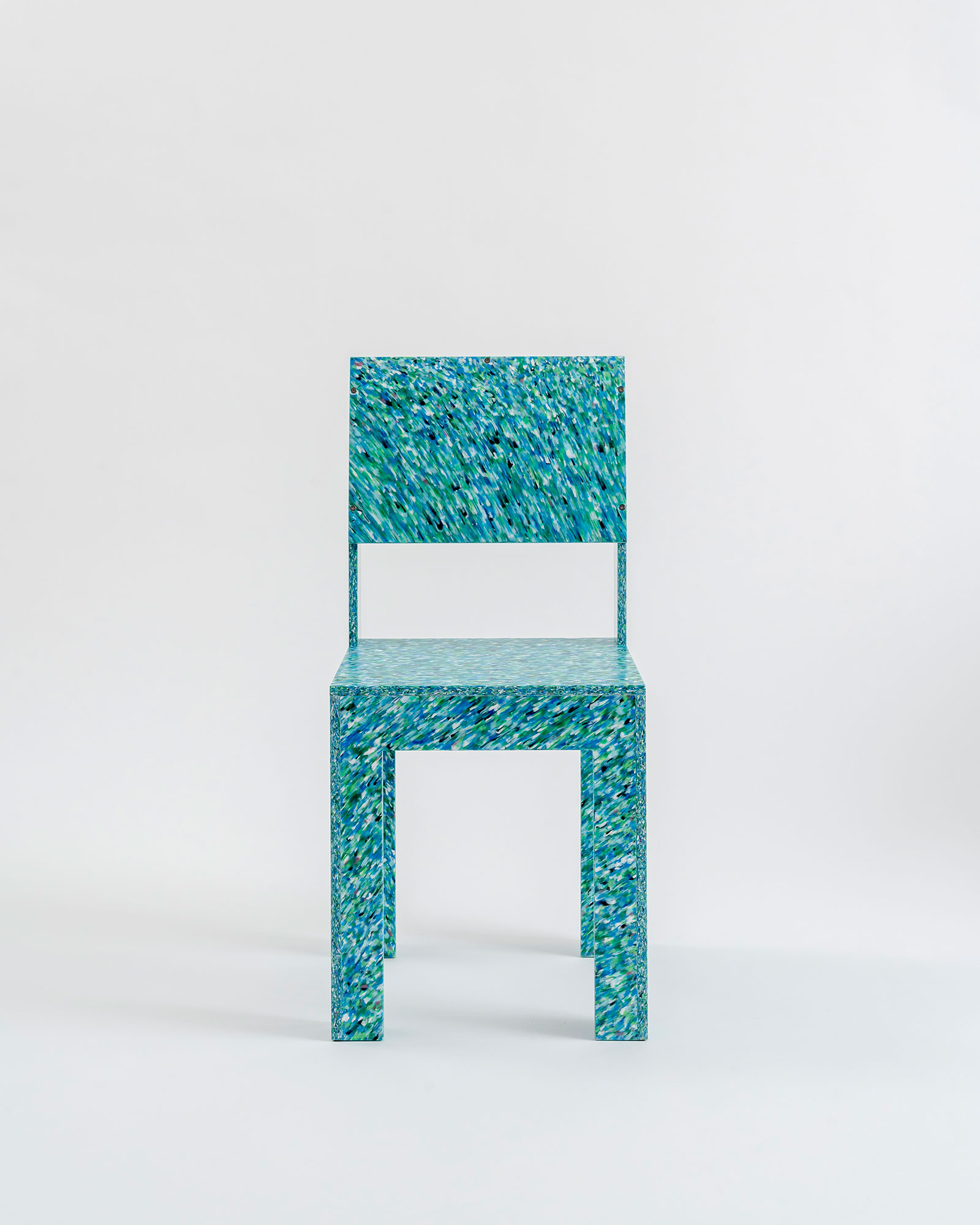Dear Ms Bargna, to start with, tell us something about yourself and your collection. How long have you been involved with plastics in design and what makes the Design Museum in Brussels stand out?
Cristina Bargna: I am an Industrial Designer. Growing up in the north of Italy, I’ve always been surrounded by design and historical factories working mainly with wood and plastics. During my studies at Politecnico di Milano, I became familiar with the methods and the values of Industrial Design as a trans-disciplinary profession that through a problem-solving process aims at creating a better quality of life. Unexpectedly, I discovered a fascination for the impact of plastics on an Italian society that, with its strongly rooted craftsmanship tradition, needed to be rebuilt in the postwar and experienced the miracolo economico.
In 2015, the inauguration of the Design Museum Brussels caught my attention and I got to Brussels the year after. The Plastic Design Collection, gathered since the 1980s by the Brussels collector Philippe Decelle (1949) and enriched after the opening of the museum with donations and acquisitions, counts around 2300 objects entirely made from plastics. Together with the 800 m2 homonymous permanent exhibition, it offers a unique occasion to understand the 20th and 21st centuries through the particular relationship between design and plastics, from the Golden Sixties and their economic boom until today and our new outlook on mass production, consumerism and sustainability.

While the exhibition PLASTIC WORLD at the SCHIRN deals with the material history of plastic in art, your collection specializes in design. How have designers taken up the new material?
Cristina Bargna: I would say that designers had an infatuation with plastics and their limitless possibilities. Plastic has no shape to begin with. It is, so to speak, neutral: it receives its shape only through the vision of the designer. If, at the beginning of 20th century, polymers were a substitute for luxurious materials, such as ivory, or were employed in military or transportation industry, they soon revealed their potential. These objects made from plastics, changed the world and the perception of reality, because everyone could have them.
In 1939, the visitors of the World Fair in New York, discovered Bakelite, Nylon or Plexiglas and left with the idea of having seen a future of progress and freedom in which the new synthetic polymers would have played a decisive role. The initial negative assessment of plastic objects, leaving no trace of the work and the hand of the craftsman, was soon replaced by a desire for this alchemical world built up inside the mould. Designers and industries attempt to create a new relationship between the user and the daily objects, which became products. New places of consumption as supermarkets or big malls, along with mail-order catalogues and the arrival of radio, encouraged mass consumption in which advertising played a central role. Customers could imagine the objects in their own homes, bringing to life the utopia of a bright light future where these colorful and easy to produce goods created new desires and changed the way of living.

How would you describe the handling of plastics in design since the emergence of the "Plastic Age" as a whole - did plastic euphoria predominate, as can be observed in Pop Art, for example, or were there also designers who, comparable to the Nouveaux Réalistes in art, critically examined the material as early as the 1960s?
Cristina Bargna: The arrival of thermoplastic polymers such as ABS and polyethylene, which were more malleable and easier to produce, led to an explosion of mass production in the 1950s and 1960s. This desire for renewal that characterizes the Golden Sixties, the years when bright Pop colours met faith in technology and the rounded shapes of the conquest of space, was quickly overtaken, in the late 1960s, by the experiments with PVC and polyurethane, new soft plastics. These objects marked a turning point, rejecting the paradigm that form must follow function. The solid Greek column falls down and breaks into several pieces with the “Capitello” (1971) armchairs by Studio 65. The established values of permanence and monumentality transform into a soft surface that takes the shape of the body that sits in it. Plastics, freed from the burden of tradition, provoke, infiltrate and phagocytize the channels of industrial production and distribution by disguising and inviting the user to experiment new ways of interactions.

Studio 65: Capitello, 1971, Image via markanto.de
Polymers, which are one of the fundamentals behind the blast of mass production and consumption, become the tool that designers and artists exploit to question the capitalist system subject to the laws of the market and their role in it. For example, the artist and activist Piero Gilardi, a representative of radical design in the late 1960s, denounced an artificial way of life, as well as industrialization and consumerism, with his “Tappeti” which are hyper-realistic reproductions of natural environments, recreated using industrial materials like expanded polyurethane and synthetic pigments.
If in the 1960s-1970s, designers used plastics either to exploit the possibilities of the material or to react to its ephemerality, while nowadays they explore the possibilities of transforming the waste. The rules of the game changed: on one hand, they try to find new sources, way of producing or using objects, on the other, they face the new identity of this material that, now, already has a shape, a color and some particular properties.

Which design schools are particularly noteworthy in the 20th century and what distinguished them?
Cristina Bargna: To me, the most influential and progressive school in the 20th century was the Ulm School of Design (Hochschule für Gestaltung Ulm). Heir of the Bauhaus experience and founded in 1947, the school detached quickly from its founder Max Bill’s (1908-1994) vision, more oriented towards craftsmanship, with the arrival of Tomas Maldonado (1922-2018) and Hans Gugelot (1920-1965). It intended to become an international center for the design and development of products, but also to give the designers a sense of social responsibility. At the end of the 1940s, they already introduced the principle of eco- sustainability and stated the ethical-social role of design. They integrated traditional design studies with scientific disciplines such as cybernetics, information theory, semiotics, ergonomics, or bionics, in order to improve the understanding of the relationship between human beings and the natural, technical or economic habitat.
Fundamental, the collaboration between the students and noteworthy industries, such as IBM, Olivetti, Fiat or Hermann Miller, to design democratic and responsible solution turned into objects, graphics, or packaging. The fruitful partnership with Dieter Rams (1932) and the German company Braun, for example, led to the design of one of the most famous Braun’s products: the Sixtant shaver (1961). It is very difficult to choose one iconic object to represent the complexity and the significance of plastic design, especially when we talk about a family of polymers with their own distinctive esthetic outcome and mechanic properties. However, this tiny everyday object embodies most of the aspects that characterized the success of this material after World War II: it is the result of a user-centric problem-solving process driven by innovation in technology and use of materials, ergonomics, accessibility...and color.

Sixtant“-Rasierer, 1961, Image via the-frankfurter.com
Quite apart from the devastating consequences for the environment, for what reasons should the use of plastics be reconsidered and greatly reduced from today's perspective, what are the pitfalls of plastic in design?
Cristina Bargna: The oil crisis of 1973, showed our dependence on fossil fuels and how plastic has been filling up and contaminating our surroundings and also our bodies. Tomas Maldonado in “La Speranza Progettuale” (1971) already highlighted how we can’t get rid of plastic as, even when they degrade, the just go back to their initial molecular and chemical state, mutating into pollutants that don’t occupy habitable spaces, but contaminates them, corrodes them. The consequences do not only concern the environment, but also our health. If latest studies demonstrated that micro plastics not only have been detected in the blood, but they can travel around the body and may abide in organs, in 1972 the Washington Post already published an article announcing that plasticizers had been found in human bloodstreams. The fact that the studies revealed the presence of plastics such as PVC or Polypropylene, which are mainly used for Single-use plastic products (SUPs) like straws, bottles, cutlery or packaging wraps, queries if the real problem is plastic, or how we design, consume and dispose it.
However, if we change the parameters and the context of analysis, when an object made from plastic enters the museum, it doesn’t seem everlasting. On the contrary, in some cases, their degradation is faster than other natural materials, leading us to deal with both new and rapid ageing processes, and the awareness that such a collection is in danger. Today, we observe that some objects have become too fragile to be displayed or even to be removed from their transport crate, as happened to the two “Tappeti” by Piero Gilardi, exhibited in PLASTIC WORLD.
Since the emergence of plastic in Design, has there been a rethinking of designers' use of materials - how does it manifest itself and where does plastic stand in contemporary design discourses?
Cristina Bargna: Since the 1970s, both theoreticians, like Victor J. Papanek (1923 - 1998) or Ezio Manzini (1945), and designers denounced the effects of this “throwaway living” and the responsibilities that rely on all participants in the process, including the user. In 1995, after the “Autoprogettazione” project, the Italian designer Enzo Mari (1932-2020) explored the DIY design with “Ecolo”. A manual instructing on how to transform plastic washing-up liquid bottles into vases. He himself also cut up and signed a series of vases. The consumer could therefore buy Mari’s instructions or one of the signed vases. Mari not only focused on the importance of recycling, but also questioned the role of open source to pursue the democratic mission of design. If some questioned the system, other designers explored the material itself, looking for alternatives in bio sources plastics or improving technologies to recycle polymers. The iconic chair “RCP2” (1992) by British designer Jane Atfield (1964) recently celebrated its 30th anniversary. The chair, resulting from post-consumer plastics such as shampoo bottles, was a project pioneering and developing recycled plastics in the UK.
Multiple possible scenarios unfold: if on one hand some designers react to and leave the economic capitalistic systems, other works inside the industry, pushing the research on new alternative materials and processes that slow down the rhythm of production and the quantity of material and energy waste, for the entire lifecycle of manufactured objects.
/https://www.repstatic.it/content/localirep/img/rep-roma/2019/07/16/111056744-2637fcc9-4185-4da6-82d3-f2deac3c4fb6.jpg)
Enzo Mari: Ecolo, Alessi, Image via basilearteco.it

Jane Atfield: RCP2, 1992, Image via thedesignedit.com
What do these changes mean for your collection and the museum, how do you react to them?
Cristina Bargna: The initial utopia and faith in polymers, definitely transformed into a global crisis, investing all the aspects of our life. The core of our collection was constituted by Philippe Decelle following some criteria, the main of which was the choice of plastics for their technical or esthetical properties and not because of their cost. The Plastic Design Collection gathers objects that reflect their era in terms of their symbiosis with, or reaction to, the industrial context and consumer society. Today we’re mapping the new paths explored by designers, in terms of new materials, new assets or ways of fabricating. We’re progressively enriching the collection with both historical and contemporary pieces that could complete the narrative and illustrate the current landscape where the frontier between art, design, craftsmanship, as well as between physical and digital blurs. In the same time, the museum is progressively improving the conservation conditions of the collection in the storage, where the objects are already divided by type of plastic. We aim at informing the public about the complexity of preserving this 20th century heritage and at arousing the interest of a new generation of restorers for this domain. For example, we’ve been collaborating with the École nationale supérieure des arts visuels –ENSAV La Cambre in Brussels, that opened a training in the conservation-restoration of works and objects made from synthetic materials.
Another axe that we’ve been starting to explore is the integration of digital tools in our daily practices. The project is at its early stages, but we count on publishing our inventory online, in order to preserve, at least the visual memory, and to give a wider access to the plastic heritage.
Can you give a forecast of where design will go in the next few years?
Cristina Bargna: It is difficult to think about completely replacing plastic, at least in the short term. The problem is bigger than the material, which itself didn’t create the throwaway lifestyle. Economic and social impulses or behaviors played a significant part in the process that led to a disposable culture. Let’s think about single use cutlery, it became mass produced in the 1950s, when the middle raising class started to travel by plane or train and ate on the move. Marketing strategies shaped a desirable future invaded by ephemeral products of momentary functionality. We need to look at a more complex net, interweaving diverse factors like the over exploitation of raw materials or the delocalization of manufacturing processes. The consequences of the pandemic, the Ukrainian war, the transition to digital and the raise of A.I., to mention a few, pushed us to reconsider more and more our relationship and dependence on fossil fuels, as well as to question what living in the city and in a community entails. We should all reexamine the production, the design and the using of these objects, as the change should come not just from industry, but also from consumers. The overflow of single-use plastics waste, as well as the over consumption of paper or electricity for all the electronic devices that are slowly replacing human gestures and rituals are a fact, and they represent a way of living that has become unbearable.
We should, at the same time, explore new practices and systems while improving the actual ones, in order to go back to the word “project” itself, which prefigures the action of projecting ahead and anticipating the following step to a new desirable future.

